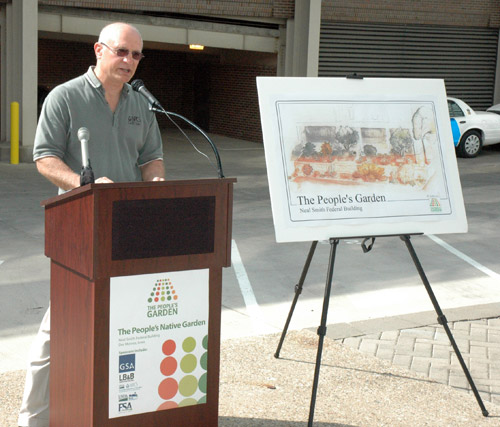By Sammi Citron, News Services Information Assistant
Huddled around the flowering magnolia tree at the U.S. National Arboretum was a mix of suits, school uniforms and jerseys, as Secretary Vilsack, local D.C. schoolchildren and NFL Washington Redskin players Malcolm Kelly and Reed Doughty helped celebrate Arbor Day by cementing the new trees’ roots with mulch. Kicking off the inaugural dig was Secretary Vilsack, who called upon the single Raven’s fan in the crowd to help him – a tidbit he found out after taking an NFL survey amongst the kids. Arboretum employees quickly answered questions about gardening, (did you know tree’s roots grow 18 inches into the ground?) but not as fast as the children managed another spitfire round as they excitedly tested how much soil they could fit onto their shovels as compared to the football stars towering feet over them.
The children ran from booth to booth learning about different kinds of lettuce, – “there’s more than one?” was their general inquisition – herbs, and chili peppers. At another station, Doughty and Kelly showcased their teamwork as they dug holes for the kids to plant in. During a taste test of several locally-grown ingredients, the kids and players chanted “Mr. Secretary, you can handle it!” as he chewed a particularly strong mustard seed, and they even compared the mint flavor in toothpaste to homegrown mint leaves.
Mike Mangiaracina, science teacher at Brent Elementary, said lessons like these help the kids relate gardening and healthy eating to their everyday lives. “As we were driving in, the kids joked that they were in the country. Driving in from New York Avenue, it’s great for them to see that their city has this, and this isn’t that far away from their world,” said Mangiaracina.
To further encourage a healthy lifestyle was Fuel Up to Play 60, an in-school program that incorporates 60 minutes of daily physical activity with a balanced diet. Doughty and Kelly were the program’s representatives for the day, and they came bearing gifts. All of the participants received Fuel Up to Play 60 hats, which they wore as they tested their pigskin-throwing skills with some of Washington’s finest. Secretary Vilsack, hat in hand, cheered from the sidelines with each catch.
Wrapping up the afternoon was the National Dairy Council, another driving force behind the Fuel Up to Play 60 program. Between Secretary Vilsack, players Kelly and Doughty, Councilman Thomas and the kids, were “Got Milk?” mustaches that rivaled the some of the most memorable advertisements.
After the touchdown dance competition was squared away and everyone was leaving, Secretary Vilsack stole a moment with one of the younger participants, giving her a special coin of his. She happily accepted, grinning ear-to-ear with her milk mustache.

Agriculture Secretary Tom Vilsack joined Washington, DC, school children from Brent Elementary and Center City Public Charter, Trinidad Campus and NFL Washington Redskins Wide Receiver Malcolm Kelly and Safety Reed Doughty at the U.S. National Arboretum to celebrate the 138th Arbor Day.

Agriculture Tom Secretary Vilsack (center) listens as Billie Parus a member of the National Herb Society and Tanya Zastrow, Volunteer/Intern Coordinator, National Arboretum explain the different varieties of mint to students from Center City Public Charter, Trinidad Campus, Washington, DC.

NFL Washington Redskins Wide Receiver Malcolm Kelly (left), Agriculture Secretary Tom Vilsack (center), and Washington Redskins Safety Reed Doughty (right) display their milk mustaches received at the “Milk Mustache Mobile” sponsored by the Dairy Processor Education Program. The “Fuel Up to Play 60”campaign USDA is in partnership with the National Football League and the National Dairy Council to encourage children to eat well get outdoors and be active.








